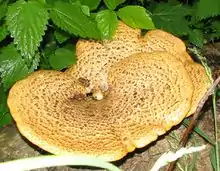| Cerioporus | |
|---|---|
 | |
| Cerioporus squamosus | |
| Scientific classification | |
| Domain: | Eukaryota |
| Kingdom: | Fungi |
| Division: | Basidiomycota |
| Class: | Agaricomycetes |
| Order: | Polyporales |
| Family: | Polyporaceae |
| Genus: | Cerioporus P.Micheli ex Adans. (1763) |
| Type species | |
| Cerioporus squamosus (Huds.) Quél. 1886 | |
Cerioporus is a genus of fungi in the family Polyporaceae. The type species is Cerioporus squamosus. Many species in Cerioporus were formerly placed in the genus Polyporus, however phylogenetic analysis shows that Cerioporus is a separate genus.[1] It has been reported that mushrooms have significant antioxidant and antimicrobial activity. [2]
Structure of basidiocarp
The basidiocarps are tough, especially when mature. The form is polyporoid to trametoid. The spores are fusoid.[1]
Hyphae
The hyphae are dimitic, composed of binding or skeletal hyphae. The skeletal hyphae are inflated and axial.[1]
Species
- Cerioporus admirabilis
- Cerioporus choseniae
- Cerioporus corylinus
- Cerioporus hygrocybe
- Cerioporus leptocephalus
- Cerioporus meridionalis
- Cerioporus squamosus (type species)
- Cerioporus rhizophilus
- Cerioporus stereoides
- Cerioporus varius
- Cerioporus vassilievae
References
- 1 2 3 Zmitrovich, Ivan V. (2016). "Lentinoid and Polyporoid Fungi, Two Generic Conglomerates Containing Important Medicinal Mushrooms in Molecular Perspective". International Journal of Medicinal Mushrooms. 18 (1): 23–38. doi:10.1615/intjmedmushrooms.v18.i1.40. PMID 27279442. Retrieved 25 May 2016.
- ↑ Sevindik, Mustafa. "The novel biological tests on various extracts of Cerioporus varius". Fresenius Environmental Bulletin. 28 (5): 3713–3717.
External links
Wikispecies has information related to Cerioporus.
This article is issued from Wikipedia. The text is licensed under Creative Commons - Attribution - Sharealike. Additional terms may apply for the media files.
